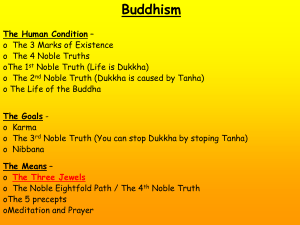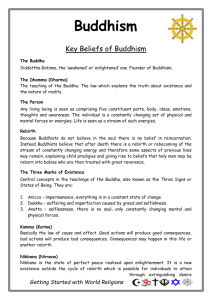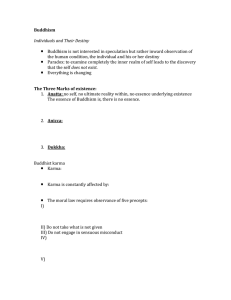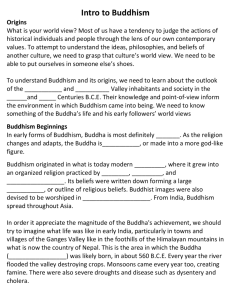Exam Revision Slides
advertisement
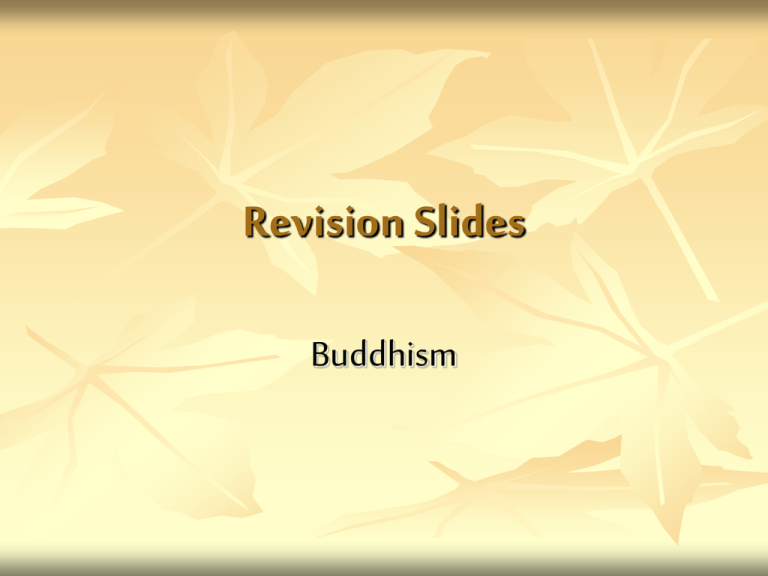
Revision Slides Buddhism Dukkha Dukkha is the first of the Four Noble Truths: Life is suffering. It is one of the three marks of conditioned existence. It is part of the Buddha’s analysis of the human condition it is generally translated as unsatisfactoriness There are three different levels of dukkha First is ordinary suffering and includes: birth, death, grief, physical pain mental anguish etc. Not getting what we want and the limits of human existence are dukkha Dukkha is caused by craving or attachment to impermanent things The Three Root Poisons The poisons are emotions: greed, hatred and ignorance Represented by three animals a pig an snake and a cockerel They are depicted at the centre of the Wheel of Life or samsara They are like the axel of the wheel; they keep it turning Being attached to the 3 poisons will mean that beings remain trapped in the cycle of samsara They are depicted biting each other’s tails to show that they feed each other Tanha Tanha translates as thirsting or craving It is the root cause of dukkha and is the second Noble Truth Tanha binds the unenlightened to samsara All things are impermanent and will pass away Nothing lasts forever, but ignorance of the true nature of reality causes the unenlightened to cling and hold on to things wishing that they will last Anicca The Doctrine of Impermanence All things change, nothing at all stays the same Change can be seen on different levels because some things change quickly while others change so slowly that we cannot see the change We change from babies to toddlers, to adolescents then to adults Cells change all the time, we are not the same as we were yesterday and we will be different tomorrow The sun seems to stay the same but it too is constantly converting helium to hydrogen and will one day cease to exist The Buddha said that there is nothing that comes into existence which does not have within it the capacity to decay As soon as we are born we are heading towards death Anatta The doctrine of no self It can be said that it is anicca applied to humans There is nothing that continues from one life to the next Nagasena explains anatta to King Milinda with the Chariot analogy There is no part of the chariot that is called chariot Sentient beings are comprised of the Five Skhandas: body, feelings, sensations, mental formations and consciousness At death the skhandas are shattered, nothing remains except kamma and consciousness Anatta 2 Holding on to the belief in a self means that one cannot be free from the cycle of Samsara They will act in a selfish way and not for the sake of others For lay Buddhists, not accepting anatta will affect future rebirths If they act from a selfish perspective they will have a less favourable rebirth in the future The illusion of a self means that the person goes through life focussed on the self, they ignore other more important things that will bring them closer to enlightenment Samsara The cycle of birth, death and rebirth The wheel of life Release from samsara is possible by following the Noble eight Fold Path The state of dependent origination The aim is to live in such a way as to ensure a better rebirth especially for lay Buddhists Rebirth depends on kamma A flow of ever changing consciousness Six states of existence all dependent on karma Kamma kamma or karma means action The law of karma is the law of cause and effect related to intentional action Karma can be good or bad The motivation behind the action causes either good or bad karma If the motivation is to do good the kamma will be positive If the motivation is to cause harm, the karma will be negative Kamma affects rebirth the consequences of one’s actions may not be felt in this life but in future lives Bad circumstances in this life can be seen as a result of bad kamma from a previous life Kamma is not a punishment for wrong it is the consequence of our action Kamma is not administered by a god, it is a natural law of cause and effect The Three Jewels Sometimes referred to as the Three Refuges The Three Jewels are the Buddha, dhamma and sangha All Buddhists accept the Three Jewels, they are the foundation of Buddhism A Buddhist takes refuge in the Jewels when he/she is ordained into the monastic sangha I take refuge in the Buddha: the Buddha was the first to become enlightened and he shows what is possible. He is a role model and inspiration to others. The Buddha revealed the dhamma, he created the sangha which pass on the dhamma. The Sangha keeps the dhamma alive by teaching it to new generations. The dhamma is the teachings of the Buddha. The dhamma is not the source of enlightenment but a guide, individuals have to make the effort. The Three Jewels are inseparable as the basis of Buddhism
